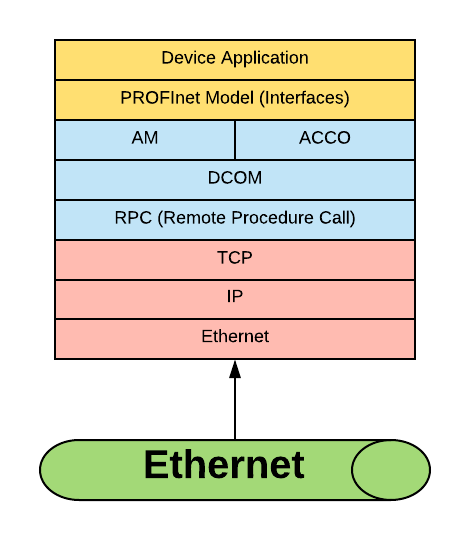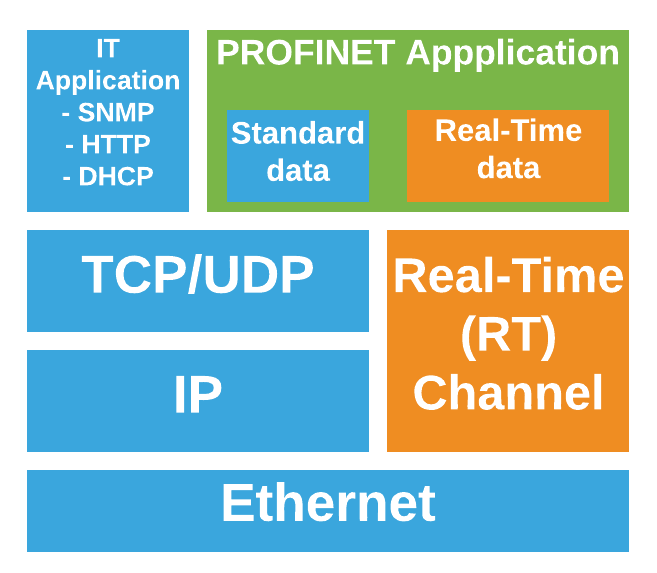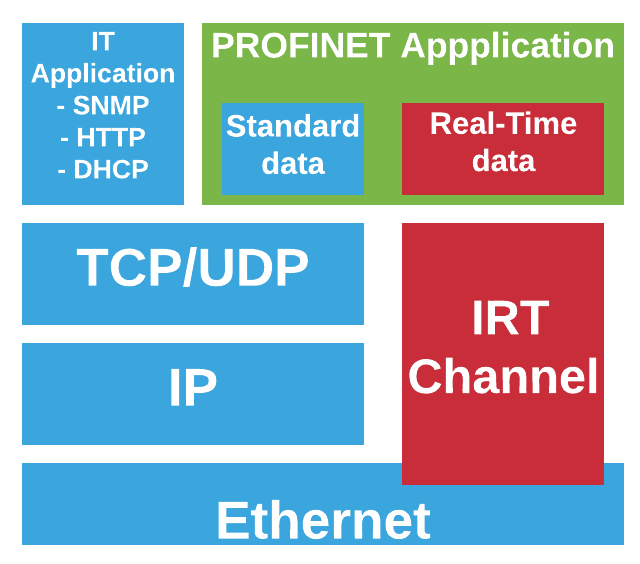The PROFINET protocol family
The PROFINET standard is maintained by the PROFIBUS and PROFINET International (PI) organisation. PROFINET is standard Ethernet, however, some extra constraints are employed because basic Ethernet is not able to guarantee the real-time behaviour required for industrial automation systems.
These extra constraints affect our choice of components and our network installation rules. PROFINET utilises TCP/IP protocols for some functions, however, it has its own channel embedded directly within Ethernet frames for real-time communications.
PROFINET consists of three main categories: PROFINET CBA, PROFINET IO, PROFINET IRT, and soon a new fourth standard called PROFINET TSN. Let’s discuss these standards in some detail…
PROFINET CBA (Component-Based Automation)
What is PROFINET CBA? How does it work?
Built on standard DCOM (Distributed Component Object Model) and RPC (Remote Procedure Call) technology, PROFINET CBA provides an integrated system from the operational network to the controller and ERP systems. PROFINET CBA views a network as composed of “Technological Components”, these components act as islands and independently coordinate their activities to form an integrated system.
DCOM is a great technology for such a system as it is an object-oriented mechanism that structures how a client (data requester) can identify, request, and transfer data from a data source. CBA uses more standard Information Technology concepts and software than any other common Industrial Ethernet, During runtime, CBA utilises TCP/IP, COM, DCOM, and RPC.
Figure (a) displays the traditional IT communication channels that CBA utilises within its framework.
Can CBA be integrated into other technologies?
CBA can be extended to PROFIBUS, AS-i, and many other protocols through the use of proxy devices.

Figure (a) – PROFINET CBA communication model
How is a CBA network configured?
A PROFINET CBA Connection Editor is used to conduct the system-specific Engineering of a network. Through a graphical interface, the user can allocate the roles and relationships between devices on the CBA network.
Device functionality is captured within XML files for import into the Connection Editor. Once the configuration is complete, the Connection Editor will automatically upload the connection configuration information to each CBA device.
The connection configuration information downloaded by each device describes:
- TCP/IP connections to be made
- Remote Procedure Calls required
- DCOM interfaces that are triggered and when they are to be triggered
How is PROFINET CBA different from other Industrial Ethernet protocols?
PROFINET CBA distinguishes itself from competitive Protocols (ModbusTCP, EtherNet/IP, etc.) through full integration of standard Information Technology functionality and principles. This makes it easier to integrate PROFINET CBA into corporate network technologies such as ERP and MES type systems.
PROFINET CBA standard is no longer supported and is very seldomly used in practice.
PROFINET IO
What is a PROFINET IO system? How does it work?
PROFINET IO is one of the most commonly installed Industrial Ethernet network technologies in the world.
Unlike PROFINET CBA that was discussed in the previous body, PROFINET IO is focused on PLC data exchange, a lot like the purpose and communication capabilities of PROFIBUS.
PROFINET IO, however, should not be confused with PROFIBUS, the two protocols are very different in structure and design. PROFIBUS uses a request/response method of communication, typically over RS-485. Whereas PROFINET IO uses cyclic data transfer between controllers and devices over Ethernet infrastructure (much like a publish/subscribe type relationship). In both PROFIBUS and PROFINET IO the PLC must have a prior user-defined configuration of the data structures between all network components.

Figure (b) – PROFINET IO Real-Time model
PROFINET IO uses two separate Ethernet-based communication channels to transfer data between the PLC and I/O devices:
- Standard TCP/IP – Used for parameterisation, configuration, and acyclic operations.
- Real-Time (RT) – Used for the transfer of standard cyclic data transfer and alarms. RT communications bypass the standard TCP/IP protocols.
Figure (b) displays the dedicated RT channel, that bypasses the standard TCP/IP layers for PROFINET cyclic data exchange and alarming events. the TCP/IP channel is utilised for parametisation and configuration of the network.
What are the benefits of a PROFINET IO system?
- Real-time performance allowing for high-speed operation due to the bypass of the TCP/IP stack
- Similar configuration and interoperation to that of PROFIBUS, allowing for simplified migration and learning
- Fast startup
- A large amount of diagnostic and configuration information capable of implementation
- Minimised commissioning time
- Very well documented and internationally supported protocol
- All PROFINET IO devices must be lab certified as part of the development cycle, thus ensuring consistency in performance and reliability
What components are found within a common PROFINET IO network?
- PROFINET IO Supervisor – Computers and alternate human interfaces for the commissioning, monitoring, diagnostics, and configuration of a PROFINET network (Similar to a Class 2 Master in PROFIBUS)
- PROFINET IO Controller – Device that controls communication and executes a program to create an automation process, often referred to as a PLC (Similar to a Class 1 Master in PROFIBUS)
- PROFINET IO Device – Any useful PROFINET cable device within an automation network, such as sensors, actuators and distributed I/O (Slave devices in PROFIBUS)
- PROFINET Switch – Switching devices are designed to connect multiple PROFINET components and control data flow. Switches can also incorporate useful features for diagnostics, security, redundancy, and network topology configuration.
How to configure a PROFINET IO network?
Configuration of a PROFINET IO network is done within configuration software supplied with the PROFINET IO Controller or Alternative PROFINET IO Supervisor tools. The following steps are required to set up a PROFINET IO network:
1. Program each I/O Device and I/O Controller individually with the following:
(i) The unique IP address for each device with a common Net ID between devices on the same network.
(ii) Unique PROFINET name for each device (PROFINET name should be descriptive on the devices’ function, category, or location).
2. Program the I/O Controller with the following parameters for each I/O Device required within the controllers’ automation program
(i) GSDML file – A GSDML file is an XML based descriptive file supplied with each I/O Device, that describes the function, configuration parameters, I/O structure and diagnostic capability of a device to the controller
(ii) The IP address of the I/O Device
(iii) The device name of the I/O Device
(iv) I/O configuration / modular build of the device. All I/O modules (hardware / Software modular) are specified at this point which defines the cyclic I/O channel data to be shared
PROFINET IRT (Isochronous Real-Time)
Why IRT? How does it work?
Traditional Ethernet-based systems integrate a technology called CSMA-CD (Carrier Sense Multiple Access – Collision Detection). This allows a common cable to carry data between multiple nodes on the network and that they are alone responsible for detecting and retransmitting upon collision events. This works very well in most situations and provides for cycle times as low a 1ms with a related jitter of around 10 to 100μs. PROFINET Conformance Class A and B devices(PROFINET IO) utilise this technology.
In specialised cases where faster cycle times and lower jitter are required for a more deterministic behaviour PROFINET IRT can be implemented. IRT utilises custom ASICs within there Conformance Class C devices, which feature a custom MAC-layer extension that allows all switches within the IRT network to provide a dedicated time slot for IRT communication only. This time slot is referred to as TDMA (Time Division Multiple Access), after which CSMA-CD is allowed for standard communication channels.
Figure (c) displays the dedicated IRT channel, that bypasses the standard TCP/IP layers, as well as integrates directly into the Ethernet layer (custom implemented IEEE 802.3).

Figure (c) – PROFINET IRT model
What are the benefits of implementing an IRT system?
- Very ‘deterministic’ behaviour, telegrams are transmitted and received on a schedule and with consistent latency
- Faster cycle times than the standard RT channel, cycle times as low as 31.25μs can be achieved
- Provides a technology solution for multi-axis motion control systems that require the increased performance
How do I implement IRT?
To implement IRT systems the following should be considered:
- Every component within an IRT network, including devices, controllers, switches must adhere to PROFINET specified Conformance Class C
- IRT synchronisation domain should be configured within the controller (Bandwidth allocation to IRT operations)
- Configure topology within the IRT controller, this allows it to optimise the transmission schedule
- PI (PROFINET International) has developed an in-depth installation guideline, that should be studied and adhered to during the design phase of your IRT network. The guideline can be found here.
PROFINET TSN (Time Sensitive Network)
Soon to be released, TSN is the newest and latest standard for PROFINET and hopes to replace the standard PROFINET IRT principles.
Industrial Connectivity Made Simple

Our expertise lies in establishing, maintaining, and leveraging plant data for business benefit. Through our innovative solutions, we work alongside you to streamline processes, enhance efficiency, and reduce costly downtime.
CONTACT US
Main: +27 (11) 548 9960
Sales: +27 (11) 548 9970
SOCIAL MEDIA
